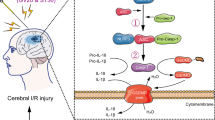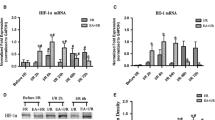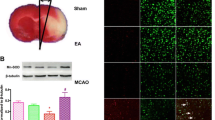Abstract
Electroacupuncture (EA) pretreatment, electrical stimulation using metal needle at specific acupoints in advance, possesses the potential to prevent cerebral ischemia-reperfusion injury (CIRI). Transient receptor potential vanilloid 1 (TRPV-1) has been indicated to take part in cerebral protection of EA; however, the detailed mechanisms remain unclear. The aim of this study was to investigate whether neuroprotection of EA pretreatment against CIRI is associated with TRPV-1 and explore the underlying mechanisms. Middle cerebral artery occlusion (MCAO) was performed to induce CIRI after EA pretreatment at Baihui (GV20), bilateral Shenshu (BL23), and Sanyinjiao (SP6) acupoints in rats. Neurological deficit scores, infarct volumes, oxidative stress damage, inflammatory cytokine production, MAPK signaling activation, and the expression of TRPV-1 were assessed. EA pretreatment lowered neurological deficit scores, reduced infarct volumes, impeded oxidative stress injury, inhibited inflammatory cytokine production, curbed P38 phosphorylation, and suppressed TRPV-1 expression in MCAO rats. Attributing to inhibition of TRPV-1 expression, AMG-517 (TRPV-1 antagonist) showed the synergistic effect with EA pretreatment on the neuroprotection against ischemia-reperfusion injury. However, TRPV-1 agonists capsaicin significantly abrogated the neuroprotective effects of EA pretreatment in MCAO rats accompanying enhancement of TRPV-1 expression. These findings indicated EA pretreatment exerted neuroprotection in rats with cerebral ischemia-reperfusion injury, which at least partially were associated with TRPV1-mediated anti-oxidant stress and anti-inflammation via inhibiting P38 MAPK activation.








Similar content being viewed by others
References
Grysiewicz, R.A., K. Thomas, and D.K. Pandey. 2008. Epidemiology of ischemic and hemorrhagic stroke: incidence, prevalence, mortality, and risk factors. Neurologic Clinics 26: 871–895.
Pan, J., A.A. Konstas, B. Bateman, G.A. Ortolano, and J. Pile-Spellman. 2007. Reperfusion injury following cerebral ischemia: pathophysiology, MR imaging, and potential therapies. Neuroradiology 49: 93–102.
Adibhatla, R.M., and J.F. Hatcher. 2008. Tissue plasminogen activator (tPA) and matrix metalloproteinases in the pathogenesis of stroke: therapeutic strategies. CNS & Neurological Disorders Drug Targets 7: 243–253.
Campbell, B.C.V., G.A. Donnan, P.J. Mitchell, and S.M. Davis. 2016. Endovascular thrombectomy for stroke: current best practice and future goals. Stroke and Vascular Neurology 1: 16–22.
Zhuang, Y., J.J. Xing, J. Li, B.Y. Zeng, and F.R. Liang. 2013. History of acupuncture research. International Review of Neurobiology 111: 1–23.
Ulett, G.A., S. Han, and J.S. Han. 1998. Electroacupuncture: mechanisms and clinical application. Biological Psychiatry 44: 129–138.
Zhan, J., R. Pan, M. Zhou, F. Tan, Z. Huang, J. Dong, and Z. Wen. 2018. Electroacupuncture as an adjunctive therapy for motor dysfunction in acute stroke survivors: a systematic review and meta-analyses. BMJ Open 8: e017153.
Sun, N., X. Zou, J. Shi, X. Liu, L. Li, and L. Zhao. 2005. Electroacupuncture regulates NMDA receptor NR1 subunit expression via PI3-K pathway in a rat model of cerebral ischemia-reperfusion. Brain Research 1064: 98–107.
Siu, F.K., S.C. Lo, and M.C. Leung. 2004. Electroacupuncture reduces the extent of lipid peroxidation by increasing superoxide dismutase and glutathione peroxidase activities in ischemic-reperfused rat brains. Neuroscience Letters 354: 158–162.
Chen, Y., Y. Lei, L.Q. Mo, J. Li, M.H. Wang, J.C. Wei, and J. Zhou. 2016. Electroacupuncture pretreatment with different waveforms prevents brain injury in rats subjected to cecal ligation and puncture via inhibiting microglial activation, and attenuating inflammation, oxidative stress and apoptosis. Brain Research Bulletin 127: 248–259.
Cheng, C.Y., J.G. Lin, N.Y. Tang, S.T. Kao, and C.L. Hsieh. 2015. Electroacupuncture at different frequencies (5Hz and 25Hz) ameliorates cerebral ischemia-reperfusion injury in rats: possible involvement of p38 MAPK-mediated anti-apoptotic signaling pathways. BMC Complementary and Alternative Medicine 15: 241.
Bai, J., F. Liu, L.F. Wu, Y.F. Wang, and X.Q. Li. 2018. Attenuation of TRPV1 by AMG-517 after nerve injury promotes peripheral axonal regeneration in rats. Molecular Pain 14: 1744806918777614.
Pegorini, S., D. Braida, C. Verzoni, C. Guerini-Rocco, G.G. Consalez, L. Croci, and M. Sala. 2005. Capsaicin exhibits neuroprotective effects in a model of transient global cerebral ischemia in Mongolian gerbils. British Journal of Pharmacology 144: 727–735.
Longa, E.Z., P.R. Weinstein, S. Carlson, and R. Cummins. 1989. Reversible middle cerebral artery occlusion without craniectomy in rats. Stroke 20: 84–91.
Shen, M.H., C.B. Zhang, J.H. Zhang, and P.F. Li. 2016. Electroacupuncture attenuates cerebral ischemia and reperfusion injury in middle cerebral artery occlusion of rat via modulation of apoptosis, inflammation, oxidative stress, and excitotoxicity. Evidence-based Complementary and Alternative Medicine 2016: 9438650.
Kumar, A., Aakriti, and V. Gupta. 2016. A review on animal models of stroke: an update. Brain Research Bulletin 122: 35–44.
Wu, Z., Z. Zou, R. Zou, X. Zhou, and S. Cui. 2015. Electroacupuncture pretreatment induces tolerance against cerebral ischemia/reperfusion injury through inhibition of the autophagy pathway. Molecular Medicine Reports 11: 4438–4446.
Jung, Y.S., S.W. Lee, J.H. Park, H.B. Seo, B.T. Choi, and H.K. Shin. 2016. Electroacupuncture preconditioning reduces ROS generation with NOX4 down-regulation and ameliorates blood-brain barrier disruption after ischemic stroke. Journal of Biomedical Science 23: 32.
Wu, C.X., Y.H. Feng, L. Yang, Z.L. Zhan, X.H. Xu, X.Y. Hu, Z.H. Zhu, and G.P. Zhou. 2018. Electroacupuncture exerts neuroprotective effects on ischemia/reperfusion injury in JNK knockout mice: the underlying mechanism. Neural Regeneration Research 13: 1594–1601.
Khoshnam, S.E., W. Winlow, M. Farzaneh, Y. Farbood, and H.F. Moghaddam. 2017. Pathogenic mechanisms following ischemic stroke. Neurological Sciences 38: 1167–1186.
Hüttemann, M., P. Pecina, M. Rainbolt, T.H. Sanderson, V.E. Kagan, L. Samavati, J.W. Doan, and I. Lee. 2011. The multiple functions of cytochrome c and their regulation in life and death decisions of the mammalian cell: From respiration to apoptosis. Mitochondrion 11: 369–381.
Li, W., and S. Yang. 2016. Targeting oxidative stress for the treatment of ischemic stroke: Upstream and downstream therapeutic strategies. Brain Circulation 2: 153–163.
Amantea, D., C. Tassorelli, F. Petrelli, M. Certo, P. Bezzi, G. Micieli, M.T. Corasaniti, and G. Bagetta. 2014. Understanding the multifaceted role of inflammatory mediators in ischemic stroke. Current Medicinal Chemistry 21: 2098–2117.
Sun, J., and G. Nan. 2016. The mitogen-activated protein kinase (MAPK) signaling pathway as a discovery target in stroke. Journal of Molecular Neuroscience 59: 90–98.
Lan, X., X. Zhang, G.P. Zhou, C.X. Wu, C. Li, and X.H. Xu. 2017. Electroacupuncture reduces apoptotic index and inhibits p38 mitogen-activated protein kinase signaling pathway in the hippocampus of rats with cerebral ischemia/reperfusion injury. Neural Regeneration Research 12: 409–416.
Randhawa, P.K., and A.S. Jaggi. 2017. A review on potential involvement of TRPV1 channels in ischemia-reperfusion injury. Experimental Neurology 295: 66–76.
Miyanohara, J., H. Shirakawa, K. Sanpei, T. Nakagawa, and S. Kaneko. 2015. A pathophysiological role of TRPV1 in ischemic injury after transient focal cerebral ischemia in mice. Biochemical and Biophysical Research Communications 467: 478–483.
Lin, Y.W., and C.L. Hsieh. 2010. Electroacupuncture at Baihui acupoint (GV20) reverses behavior deficit and long-term potentiation through N-methyl-d-aspartate and transient receptor potential vanilloid subtype 1 receptors in middle cerebral artery occlusion rats. Journal of Integrative Neuroscience 9: 269–282.
Wang, Z., T. Chen, M. Long, L. Chen, L. Wang, N. Yin, and Z. Chen. 2017. Electro-acupuncture at Acupoint ST36 ameliorates inflammation and regulates Th1/Th2 balance in delayed-type hypersensitivity. Inflammation 40: 422–434.
Wang, Z., T. Yi, M. Long, Y. Gao, C. Cao, C. Huang, Q. Wang, N. Yin, and Z. Chen. 2017. Electro-acupuncture at Zusanli Acupoint (ST36) suppresses inflammation in allergic contact dermatitis via triggering local IL-10 production and inhibiting p38 MAPK activation. Inflammation 40: 1351–1364.
Funding
This work was supported by a grant from National Natural Science Foundation of China (No. 81574055).
Author information
Authors and Affiliations
Contributions
M.L., Z.G.W., N.N.Y., and Z.B.C. designed the study. M.L and Z.G.W. performed the experiments, analyzed the data, and wrote the manuscript. D.Z., W.T.T., and J.J.C contributed to the animal feeding and preparation of MCAO model. L.W. and N.N.Y. provided technical assistance of sample collection and results analysis for transmission electron microscope. N.N.Y. and Z.B.C revised the manuscript.
Corresponding authors
Ethics declarations
Conflict of Interest
The authors declare that they have no conflicts of interest.
Additional information
Publisher’s Note
Springer Nature remains neutral with regard to jurisdictional claims in published maps and institutional affiliations.
Rights and permissions
About this article
Cite this article
Long, M., Wang, Z., Zheng, D. et al. Electroacupuncture Pretreatment Elicits Neuroprotection Against Cerebral Ischemia-Reperfusion Injury in Rats Associated with Transient Receptor Potential Vanilloid 1-Mediated Anti-Oxidant Stress and Anti-Inflammation. Inflammation 42, 1777–1787 (2019). https://doi.org/10.1007/s10753-019-01040-y
Published:
Issue Date:
DOI: https://doi.org/10.1007/s10753-019-01040-y




